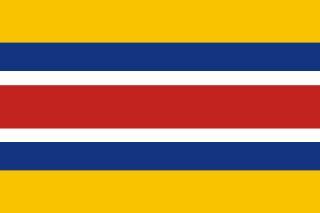 W
WDuring the Second Sino-Japanese war, the invading Japanese established a variety of puppet governments such as the Provisional Government of China and the Reformed Government of China which used the flag of Five Races Under One Union even though the legitimate Chinese Government had switched to the current day modern flag of the Republic of China.
 W
WFive Races Under One Union was one of the major principles upon which the Republic of China was founded in 1911 at the time of the Xinhai Revolution. Its central tenet was the harmonious existence under one nation of what were considered the five major ethnic groups in China: the Han, the Manchus, the Mongols, the Tibetans, and the Hui.
 W
WThe flag of Weihaiwei was the flag used by the British leased territory of Weihaiwei, during British rule between 1903 and 1930. The flag consisted of a British blue ensign with a pair of Mandarin ducks on it.
 W
WThe flag of the Empire of Manchuria had a mustard yellow field with four horizontal stripes of different colors in the upper-left corner. The colors of the flag were based on the colors on the Five Races Under One Union flags used by the Beiyang government and the Empire of China. The flag was first established in Announcement of National Flag on March 1, 1932.
 W
WThe flag used by the Mengjiang United Autonomous Government consists of a horizontal colour pattern of yellow, blue, white, red, white, blue and again yellow.
 W
WThe flag of the Qing dynasty was an emblem adopted in the late 19th century featuring the Azure Dragon on a plain yellow field with the red flaming pearl of the three-legged crow in the upper left corner. It became the first national flag of China and is usually referred to as the "Yellow Dragon Flag".
 W
WThe Tibetan flag, also known as the "snow lion flag", was the flag of the de facto independent polity of Tibet from 1916 to 1951. It was adopted by the 13th Dalai Lama in 1916. Banned by the Chinese government since 1959, the flag has not been in official use by any region in the world since 1951; however it is used by the Tibetan Government in Exile, based in Dharamshala, India.
 W
WThe Tuvan People's Republic in its short life span went through a number of flags. Many typical communist icons were used such as the Hammer and Sickle and the color red.